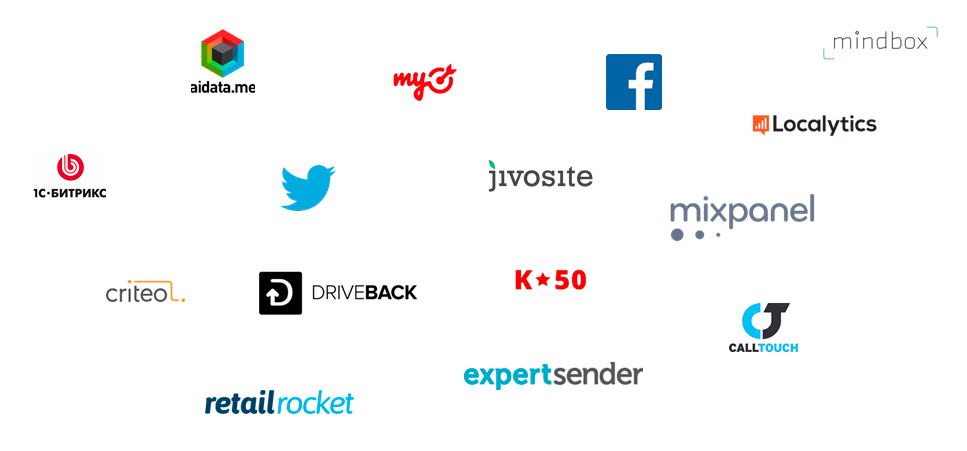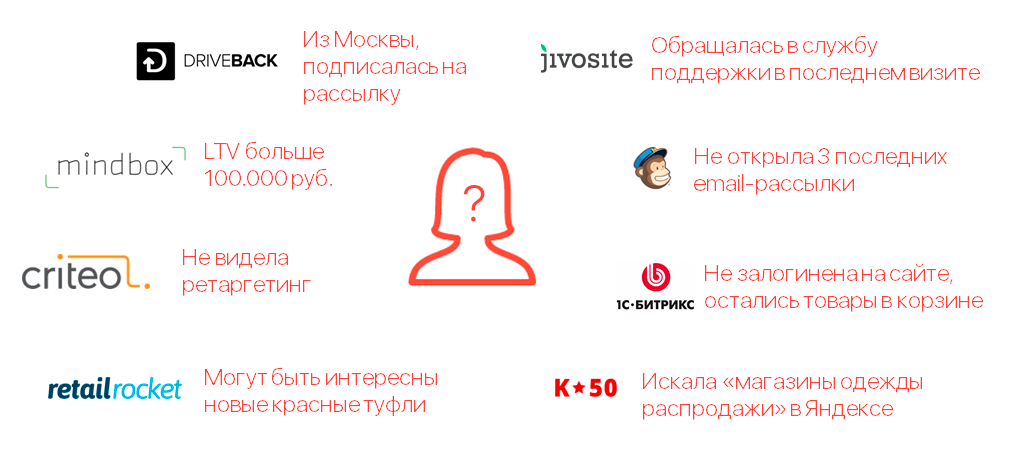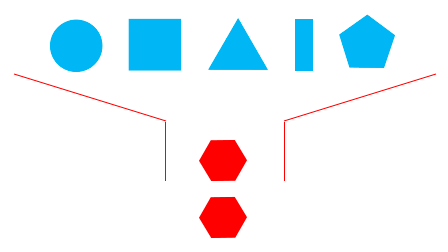Digital Data Layer - the heart of your tag-management system
It is not a secret for anyone that the more data you have about your customers, the more opportunities you have to build more personalized communications with the client, which directly affects conversion, loyalty and profit.
However, along with the fast-growing amount of data, there are more and more difficulties in their effective management. A modern online store cooperates with a large number of marketing partners, tags and services, which in order to work effectively one way or another it is necessary to transfer various data about their own users.

')
In turn, each such partner has some unique knowledge of the client, which would also be useful for an online store. However, getting this data back is sometimes not so easy. Moreover, it is necessary to stop working with a partner, they can be lost forever.
Below is an example of what data each of the third-party systems may have. All this data is often isolated and the online store does not know how to get it:

It is becoming increasingly clear the need to implement and standardize the process of transferring user data from an online store to a partner (to third-party tags) and back. The problem is that all partner systems have their own data structure, they collect and transmit them in various ways.
This leads to the fact that the data on the client side is not organized. There is no order, integrity and consistency. There is no control over how and by whom data is collected and used.
Attempts to understand this chaos of data take a huge amount of time and money, which does not at all correspond to a fast and flexible data-driven culture. Employees of online stores have to spend time on routine things and endless integration, instead of working on strategic objectives that directly affect profits. This significantly slows down the speed and efficiency of the organization as a whole.

Therefore, the most innovative companies have realized that before conducting any marketing activities, it is necessary to solve the issue of data organization once and for all.
The project launched a few days ago http://digitaldata.readme.io is designed to solve this problem!
Today on any modern site dozens of third-party services and tags are installed. Each of them performs different tasks and uses the data in its own format. Thus, the process of integrating such services becomes complex and inefficient. Site code is polluted, download speed decreases. Everything becomes even more complicated when there is a need to transfer data between third-party systems and tags.
To solve this problem, the Digital Data Layer standard was created. This is an open set of rules that define standards for interaction and data transfer between the site and third-party systems.

Digital Data Layer (DDL) is a global JavaScript object that contains all dynamic variables that reflect the current state of the page and user session. All variables inside the DDL can be used inside tag management systems, such as Google Tag Manager, as well as other vendors and scripts installed on the site.

For example, the DDL may contain information about the products being viewed (id, price, etc.), information about the user (name, email, this user is new or returned, whether he subscribes to the newsletter or not), or information about products that have just been bought on the e-commerce site.

If you look in the code of your Google Tag Manager, you will see what kind of chaos is going on there. Data not organized. There is no order, integrity and consistency. There is no control over how and by whom data is collected and used.
Each third-party service imposes its own format for transmitting the same data. The code of your site turns into a dump of calls to third-party tags, which leads to difficulties in understanding what is happening on the site.
With Digital Data Layer, code becomes unified and streamlined. The same data is used many times and simply converted to different formats.

Having a implemented Digital Data Layer opens up possibilities for advanced segmentation. For example, DDL allows targeting marketing campaigns according to certain criteria:

DDL also allows users to be targeted using historical data and data transmitted by third-party scripts and tags.
On every page where the Digital Data Layer is implemented - analytical systems are able to collect the information that it contains. This opens up additional possibilities in analytics and in understanding how different variables affect conversion.
But more importantly, the availability of this data helps to identify potential problems on the site. After that, based on these hypotheses can be developed to eliminate them.
Each site very often comes across the need to install and configure new tags (third-party vendor scripts). It is easy to see that most tags need the same data, for example:
As soon as you integrate the Digital Data Layer, you can install new tags without any need to make changes to the site code. All this can be done directly in your Tag Management system.

Do you want to show retargeting only to users who do not open your email list? Previously, this integration could take months. Now, all you have to do is download data from ESP about opening emails into the Digital Data Layer, which will enable the retargeting system to build the desired segment.

Do you want to completely replace any third-party system with another one, or to conduct a test between them?
Now the migration will take you no more than 5 minutes. However, no changes on the site will be required, since All communication is now conducted through a standardized data layer.

Integration of Digital Data Layer will be an invaluable investment in the future of your site, because in essence, this is the foundation of data-based marketing.

Detailed documentation and examples of the use of DDL can be found on the website ddmanager.ru .
Despite the fact that DDL can work completely autonomously (because it is a simple JavaScript object), you have the opportunity to use the Open Source library - Digital Data Manager .
Digital Data Manager contains many useful functions for working with events and changes inside the DDL. More technical documentation can be found on the project website - http://digitaldata.readme.io/docs/work-with events.
In addition, Digital Data Manager allows you to add custom integrations with which you can use DDL data and transfer it to Google Analytics, GTM, Driveback, Retail Rocket, Criteo, and any other third-party system.
The introduction of the standard has already been taken up by several fairly large online stores, and soon the first results will be known. If anyone is interested, I will be glad to share these cases in further publications.
However, along with the fast-growing amount of data, there are more and more difficulties in their effective management. A modern online store cooperates with a large number of marketing partners, tags and services, which in order to work effectively one way or another it is necessary to transfer various data about their own users.

')
In turn, each such partner has some unique knowledge of the client, which would also be useful for an online store. However, getting this data back is sometimes not so easy. Moreover, it is necessary to stop working with a partner, they can be lost forever.
Each third-party service owns a part of the puzzle, knowing some information about the user. However, the store does not have a unified and complete user profile.
Below is an example of what data each of the third-party systems may have. All this data is often isolated and the online store does not know how to get it:

It is becoming increasingly clear the need to implement and standardize the process of transferring user data from an online store to a partner (to third-party tags) and back. The problem is that all partner systems have their own data structure, they collect and transmit them in various ways.
This leads to the fact that the data on the client side is not organized. There is no order, integrity and consistency. There is no control over how and by whom data is collected and used.
Attempts to understand this chaos of data take a huge amount of time and money, which does not at all correspond to a fast and flexible data-driven culture. Employees of online stores have to spend time on routine things and endless integration, instead of working on strategic objectives that directly affect profits. This significantly slows down the speed and efficiency of the organization as a whole.

Therefore, the most innovative companies have realized that before conducting any marketing activities, it is necessary to solve the issue of data organization once and for all.
The project launched a few days ago http://digitaldata.readme.io is designed to solve this problem!
What is Digital Data Layer?
Today on any modern site dozens of third-party services and tags are installed. Each of them performs different tasks and uses the data in its own format. Thus, the process of integrating such services becomes complex and inefficient. Site code is polluted, download speed decreases. Everything becomes even more complicated when there is a need to transfer data between third-party systems and tags.
To solve this problem, the Digital Data Layer standard was created. This is an open set of rules that define standards for interaction and data transfer between the site and third-party systems.

Digital Data Layer (DDL) is a global JavaScript object that contains all dynamic variables that reflect the current state of the page and user session. All variables inside the DDL can be used inside tag management systems, such as Google Tag Manager, as well as other vendors and scripts installed on the site.

For example, the DDL may contain information about the products being viewed (id, price, etc.), information about the user (name, email, this user is new or returned, whether he subscribes to the newsletter or not), or information about products that have just been bought on the e-commerce site.

Benefits of using
CLEAN CODE
If you look in the code of your Google Tag Manager, you will see what kind of chaos is going on there. Data not organized. There is no order, integrity and consistency. There is no control over how and by whom data is collected and used.
Each third-party service imposes its own format for transmitting the same data. The code of your site turns into a dump of calls to third-party tags, which leads to difficulties in understanding what is happening on the site.
With Digital Data Layer, code becomes unified and streamlined. The same data is used many times and simply converted to different formats.

ADVANCED SEGMENTATION
Having a implemented Digital Data Layer opens up possibilities for advanced segmentation. For example, DDL allows targeting marketing campaigns according to certain criteria:
- Target users with LTV> 100 000 rub.
- Who in the last month have not opened a single letter from the list.

DDL also allows users to be targeted using historical data and data transmitted by third-party scripts and tags.
ANALYTICS
On every page where the Digital Data Layer is implemented - analytical systems are able to collect the information that it contains. This opens up additional possibilities in analytics and in understanding how different variables affect conversion.
But more importantly, the availability of this data helps to identify potential problems on the site. After that, based on these hypotheses can be developed to eliminate them.
MANAGEMENT OF THIRD PARTY SERVICES AND TAGS
Each site very often comes across the need to install and configure new tags (third-party vendor scripts). It is easy to see that most tags need the same data, for example:
- Order ID
- Order price
- List of purchased goods
- Product Name
- Item ID
- Page type
As soon as you integrate the Digital Data Layer, you can install new tags without any need to make changes to the site code. All this can be done directly in your Tag Management system.

TRANSFER OF DATA BETWEEN THIRD PARTY SERVICES
Do you want to show retargeting only to users who do not open your email list? Previously, this integration could take months. Now, all you have to do is download data from ESP about opening emails into the Digital Data Layer, which will enable the retargeting system to build the desired segment.

FAST AND PAINLESS MIGRATION
Do you want to completely replace any third-party system with another one, or to conduct a test between them?
Now the migration will take you no more than 5 minutes. However, no changes on the site will be required, since All communication is now conducted through a standardized data layer.

PROFIT FOR THE WHOLE TEAM
Integration of Digital Data Layer will be an invaluable investment in the future of your site, because in essence, this is the foundation of data-based marketing.

WHERE TO BEGIN?
Detailed documentation and examples of the use of DDL can be found on the website ddmanager.ru .
The implementation of DDL usually takes from 2 to 5 days. After completion, any new integration of third-party services will be done 8-10 times faster (often even without the involvement of IT-specialists).
Despite the fact that DDL can work completely autonomously (because it is a simple JavaScript object), you have the opportunity to use the Open Source library - Digital Data Manager .
Digital Data Manager contains many useful functions for working with events and changes inside the DDL. More technical documentation can be found on the project website - http://digitaldata.readme.io/docs/work-with events.
In addition, Digital Data Manager allows you to add custom integrations with which you can use DDL data and transfer it to Google Analytics, GTM, Driveback, Retail Rocket, Criteo, and any other third-party system.
The introduction of the standard has already been taken up by several fairly large online stores, and soon the first results will be known. If anyone is interested, I will be glad to share these cases in further publications.
Source: https://habr.com/ru/post/273307/
All Articles